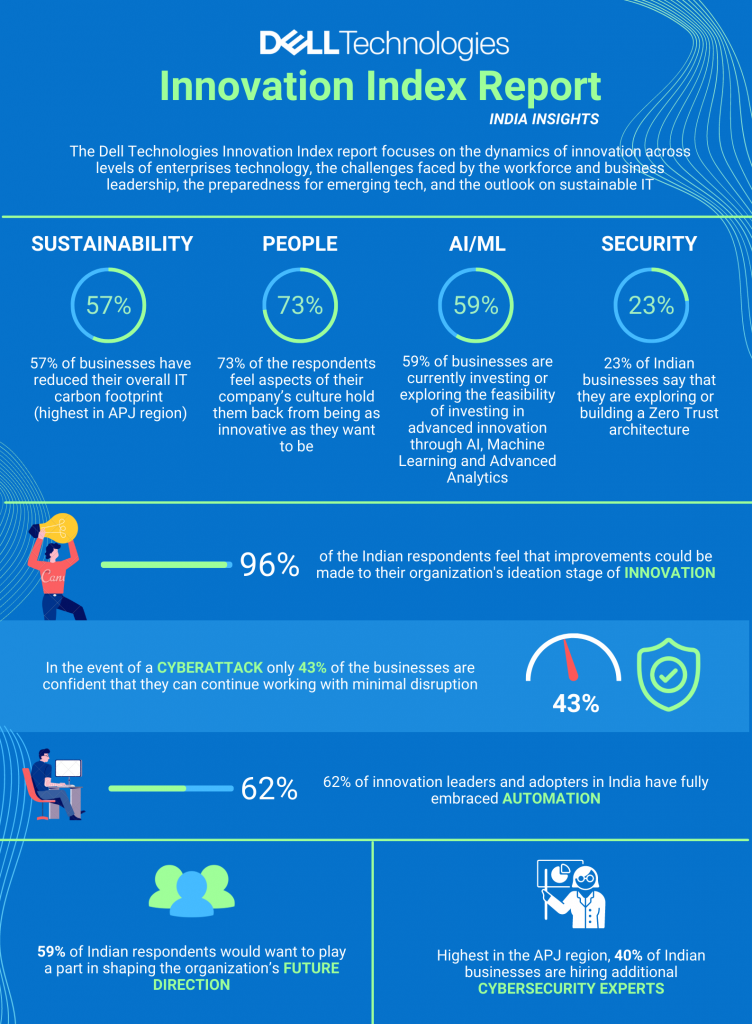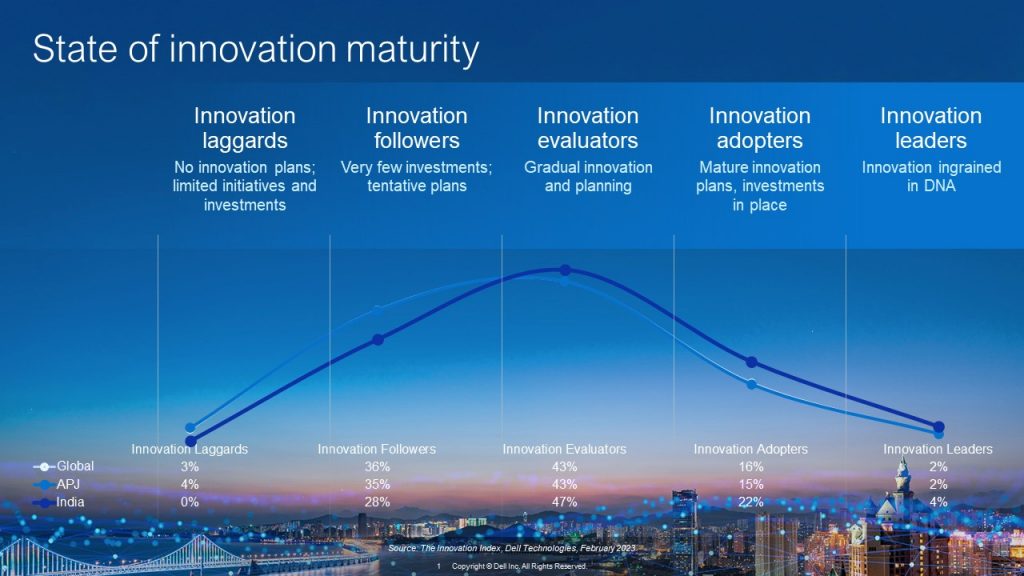60% of Indian respondents fear their organization will be irrelevant in 3-5 years, based on the health of their innovation pipeline and culture
“What businesses in India, irrespective of their size and scale cannot avoid are the right processes and technology. Value only comes when you have all three.”
Manish Gupta, Vice president, Infrastructure Solutions Group, Dell Technologies India.
The Dell Technologies Innovation Index reveals almost 6 in 10 respondents fear their organization could be irrelevant in 3-5 years, based on the health of their innovation pipeline and culture. A new study by Dell Technologies in partnership with Vanson Bourne, polling 6,600 employees across 45+ countries, illustrates why innovation is business critical and how organizations should harness their people, processes, and technologies to innovate effectively.
Innovation is business critical
Through assessing organizations, respondents are placed on an innovation maturity benchmark ranging from Innovation Leaders to Innovation Laggards. Per the analysis, just 26% of organizations in India can be defined as Innovation Leaders and Adopters. They have an end-to-end innovation strategy and are well placed to navigate headwinds coming from a global recession, supply chain issues, environmental impacts and more, and continue to grow.
In India, the Innovation Leaders and Adopters are 1.4x more likely to accelerate their innovation during a recession than Innovation Followers and Laggards (who are more likely to decelerate). This “innovation resilience” (i.e., determination and ability to innovate during tough times) is credited as part of the reason why Innovation Leaders and Adopters in India are 2.1x more likely to experience high levels of revenue growth than Innovation Laggards and Followers.
“India is seeing rapid digitization and there is a big push for businesses to become digital-first entities. With innovation at the core of this shift, we need not look back anymore. There’s a powerful equation in business: innovative idea plus technology equal impact. But there are several dependencies that are catching out organizations. They often think it’s to do with the idea. They’re waiting for the next big disruptive lightbulb moment. But small, practical ideas can create a ripple effect that leads to greater productivity, profitability and purpose. What businesses in India, irrespective of their size and scale cannot avoid are the right processes and technology. Value only comes when you have all three,” says Manish Gupta, Vice president, Infrastructure Solutions Group, Dell Technologies India.

People-primed innovation
Organizations need help to develop an innovation-first culture where all ideas can make a difference and learning through failure is encouraged, based on the following findings:
- 64% of respondent believe people leave their company because they haven’t been able to innovate as much as they hoped they would.
- 73% of Indian respondents say aspects of their company’s culture is holding them back from being as innovative as they want to be/can be.
Company culture is set and modelled by leadership but 79% say their leaders are more inclined to favor their own ideas. Some of the top respondents cited personal barriers to innovation are a fear of failure and a lack of confidence to share ideas with leaders.
Process-primed innovation
Similarly, the Innovation Index reveals that businesses are struggling to embed a structured, data-driven innovation process to realize innovation across the organization. Key findings include:
- Only 37% of IT Decision Makers in India say all their innovation efforts are based on data.
- Just 39% Indian organizations are aligning innovation projects to company goals. It’s likely, this lack of process and strategy is part of the reason why organizations are struggling to prioritize innovation. The top cited barrier to innovation is the lack of digital or technology fluency.
Technology-primed innovation
The study findings point to the power of technology to enable innovation, and the consequences of falling behind.
The vast majority of respondents (96%) are actively seeking out technologies to help them realize their innovation goal. Conversely 59% in India believe their technology is not cutting-edge and fear they will fall behind their competitors.
The study explores where organizations are making gains and facing obstacles, across five technology catalysts for innovation: multicloud, edge, modern data infrastructure, anywhere-work and cybersecurity. In nearly all areas, the greatest stumbling block to unlocking that potential is complexity. For instance, too many organizations have arrived at a multicloud environment by happenstance—an amalgamation of cloud platforms, apps, tools etc. The complexity is costing organizations time, money and precious opportunities to innovate.

These struggles are evident in the top cited global technology obstacles to innovation:
- Growing cloud costs
- Difficulties integrating the overall business architecture with the IT infrastructure architecture
- Time and money spent to migrate apps to new cloud environments
- Cybersecurity threats and insecure edge devices
- Lack of IT infrastructure to meet and process data at the edge
* Research from 45+ countries benchmarks organizations on how well they’re driving innovation


